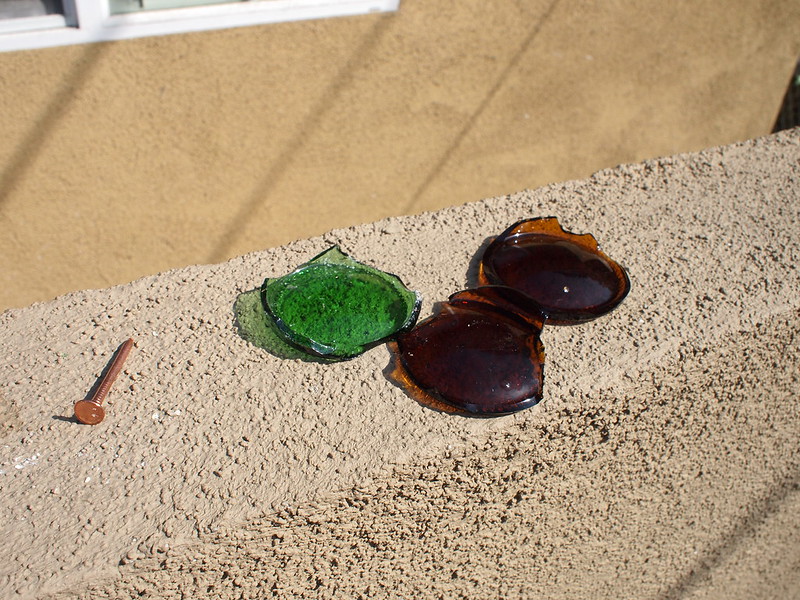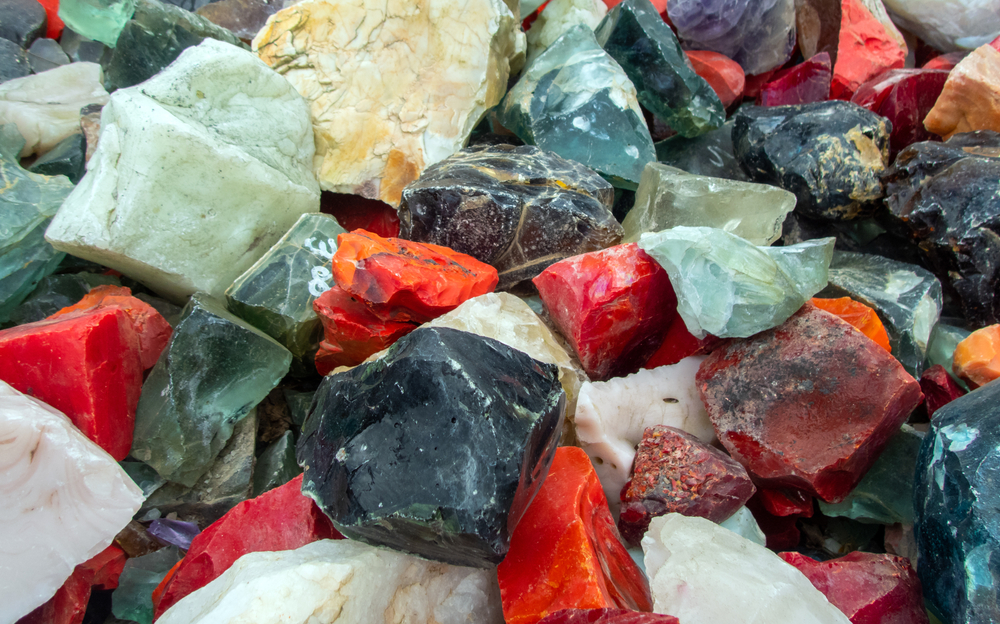- Why Use Glass for Flintknapping?
- Glass is an amorphous form of silica, ideal for sharp conchoidal fractures.
- It comes in various colors, allowing for aesthetically pleasing creations.
- Suitable for beginners due to its availability and cost-effectiveness.
- Precautions When Flintknapping Glass:
- Avoid laminated and tempered glass as they are not suitable for knapping.
- Be cautious of lead content in CRT glass and always use safety equipment.
- Glass dust can be hazardous; wear an N95 mask during knapping.
- Sources of Glass for Knapping:
- Bottle bottoms and sides can be used, with techniques to remove them efficiently.
- Landscaping glass, often cullet glass, is available in striking colors and is cost-effective.
- Slag glass and thrift store finds can also be good sources, but require careful selection.
Flintknapping Glass
Glass wasn’t exactly available to our prehistoric ancestors, but with a bit of ingenuity, it makes a great supply for the modern knapper. There are many different sources of glass, and not all glass is suitable for knapping, but knowing the difference can keep you from making some mistakes.
So, let’s take a deeper look at how to flint knap glass and some of the sources to get ahold of it!
Related: Flint Knapping for Beginners (From Raw Material To Finished Point)
Why Glass?
Glass is an amorphous form of silica, with the caveat that we’re talking about man-made glasses here instead of natural glass-like silica like obsidian or common opal. The material readily transfers shock, is generally of fairly uniform purity, and makes for a very sharp conchoidal fracture.
Glass can be found in a wide variety of highly saturated colors as well. This allows you to make more “modern” looking points, knives, and eccentrics than you can with the traditionally grey or brown chert varieties. Most of the more colorful jaspers and flints tend to require a bit of heat treatment to be flaked more uniformly as well.
So glass is both practical and opens up a different aesthetic to your pieces than you’ll find with natural stone.
You can learn virtually every part of knapping using just glass and some basic tools. It’s a great material for beginners, but it does require a bit of extra control of force since it’s more brittle than chert or flint-type materials.
All basic techniques work just fine with glass, although it can be a bit harder to see flake patterns in glass types that become highly transparent when in thinner forms.
In short, glass works and it can look great depending on where you source it. I also find it less stressful to mess up with a bit of cullet glass than with obsidian or flint, but your mileage may vary.
Related: Why is Obsidian So Good for Flintknapping? (Plus a Few Good Alternatives)
Sourcing Glass for Knapping
First things first: not all glass is suitable for knapping.
Laminated safety glass, like that found in car windows, won’t knap no matter what you do. Likewise, any form of tempered glass is unknappable. The differential stress caused by the tempering process means that the glass is way stronger than normal glass, but it also causes the glass to break rapidly and autonomously once it’s been damaged.
However, standard glass is all over the place.
Bottle Bottoms and Sides

Most glass bottles have a lens-shaped bottom. With just a few percussion flakes removed, these make a great blank, you just have to get out the concavity on one side of the bottom.
It’s also possible to remove them in a controlled fashion.
Take a large carriage bolt or nail and stick it in the empty bottle head down. Bring the bottle up and then jerk it downwards, after a couple of hits the bottom will separate with minimal inclusions from the side of the bottle.
Straight-sided bottles, like those for some liquors, are also usable. Generally, it’s easiest to remove the bottom and then begin knocking out the smaller sides. You’ll lose some material doing this, so a glass cutter can also be used if you’re particular about sparing material.
Don’t worry too much about sparing material, even the good stuff, if you’re truly picky then you can actually re-use these scraps with a method I’ll describe below.
One seemingly good source isn’t, however: coke bottles are often made of tempered glass which makes the bottom of the bottle unusable for our purposes.
Landscaping Glass
Landscaping glass is generally cullet glass, made from recycled glass from various sources. Cullet glass can be treated like obsidian for purposes of things like spalling and flaking, and it often comes in striking colors.
Unfortunately, a lot of unscrupulous (or even just ignorant) vendors sell cullet glass as “[color] obsidian” these days. Use the terms “glass for landscaping” on a site like eBay to find a good variety of the stuff. It can usually be bought for pennies to a dollar per pound depending on the coloration.
Cullet glass is often a waste product, just glass left behind in the furnace, so it can have fractures and other issues but it’s generally a good material and any larger problems will show from the outside owing to the clarity of the material.
Slag Glass

Slag glass is easy to confuse with cullet glass if you’re not well-read on the material.
While cullet glass is often the byproduct of glass production, slag glass is material left behind after smelting metal ores. This often results in opaque, banded glasses with a variety of colors and it’s often seen used in the construction of glass antiques.
Slag glass varies in price, and some of it is quite desirable.
If you’re new and not too concerned with a specific color or pattern I’d stick with purchasing landscaping glass. Slag glass is more prone to large impurities which terminate flakes and internal voids due to the nature of its creation.
Microwave Kilns
Microwave kilns are a good way to reuse glass scraps from the knapping process. Since most man-made glass is high purity, it can often be re-melted without any issues. This often results in opaque, patterned glass that’s relatively common to see in flintknapping circles these days.
You can find one online without too many issues. Just be aware that while a “cheap” method of doing things, you’ll often need at least a 15-minute cycle to melt the glass. You also need safety equipment to handle the kiln, a safe area to let the glass cool, and it’s not the most controllable method of doing things.
That said, for knapping, as opposed to art glass uses, these are actually pretty cool little tools. Those making millefiori beads will want to pass it up, but for someone who just needs something to whack into a point or blade? Well, they’re just about perfect.
TV Glass-User Beware
One of the more common sources I’ve seen people use for thick glass for knapping is the fronts of old CRT tubes from TVs. The material is thick, strong, and suitable for knapping but you need to be careful with it.
The problem is that the glass of the CRT is made with decent lead content. Lead that will become airborne quickly once you start whacking the glass.
In theory, you should be wearing a mask and using adequate ventilation already and not have to take any further precautions other than washing yourself down well after working the material. In practice, a lot of people only wear their masks when it’s convenient and lead is a faster-acting hazard than fine silica.
It’s usable, and the resulting tools are safe to use, but wear at least an N95 and thoroughly get rid of any remaining dust when you’re done using it.
Thrift Store Plates and Dishes
Thrift stores are a great place for a knapper looking for some glass. Just make sure to check any novelty-colored glasses online before you start breaking them down, if you come across some vintage jadeite or purple glass… well, that plate can probably buy a lot of obsidian or cullet glass.
You may sometimes end up with tempered glass when doing this. You’ll know when the whole thing breaks down. There are ways to tell, but mostly you just need to check the markings.
This remains my favorite way to get glass for larger “flake-over-grind” pieces. With a tile saw you can just cut preforms out of the plates and get to work.
Peculiarities of Knapping Glass
The nice thing about glass is that it’s generally a homogenous substance. While you encounter internal bubbles, they’re not as troublesome as things like pockets of ash or half-formed cristobalite in obsidian and you’re not going to suddenly hit a small vein of a disruptive mineral like pyrite while you’re working with it.
Glass dust is fairly dangerous, but it’s the same as the dust from most knapped stones. An N95 mask will handle the vast majority of particulates and it’s a good idea to get into the habit of wearing one when knapping. It’s a requirement when doing so indoors.
Glass tends to leave lots of sharp bits when you’re working on it. I generally knap in short sleeves, and I’ll receive the occasional cut on my arms when I’m working it from errant flakes. The bigger danger is stuff that gets caught on the skin and you disrupt later. A bit of dish soap and water, along with very gentle scrubbing, will handle this problem when your session is done.
Since glass is softer than flint or chert, it tends to break more readily, especially as the preform gets thinned out. Proper support is very important in the last stages of percussion flaking, as a strike above the centerline will ruin all of your hard work in short order.
Other than the above, it’s a great way for beginners to start and it’s quite cheap to get your hands on massive amounts of it as a new knapper, so give it a shot!

